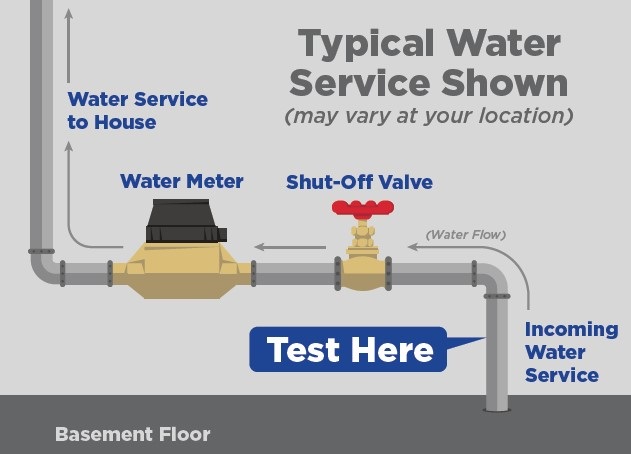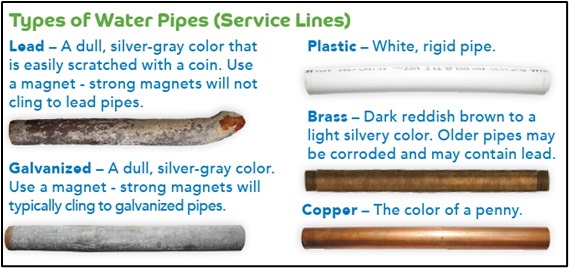HOW CAN LEAD GET INTO DRINKING WATER?
The water supply has virtually no lead in it leaving the water treatment facilities, however once it leaves the water main, it may come in contact with piping, solder, faucets or plumbing fixtures which contain lead.
The pipes beneath public roadways are publicly owned, but the portion of the pipe (the service line) that connects to household plumbing, is privately owned. These pipes can be a source of lead, water sitting in contact with lead pipes or passing through lead plumbing materials can carry lead particles or dissolved lead.
WHERE DO I FIND MY WATER SERVICE LINE?
Service lines typically enter the home in the basement through either the foundation wall or the floor, and connect to your water meter.

HOW DO I KNOW IF I HAVE A LEAD SERVICE LINE?
Click Below to access our public map of service line materials:
Or, take a look at your incoming water line as shown below:

You cannot taste, smell, or see lead in water. Lead plumbing pipes are generally a dull gray color and are very soft. If you carefully scratch a pipe with a key or coin, the scratched area on a lead pipe will turn a bright silver color. Galvanized (Steel) piping can also be dull gray in color. A strong magnet will typically cling to galvanized pipes, but will not cling to lead pipes or copper plumbing which has the same color as a copper penny. Plastic water pipes are often blue or black but can be another color and are usually easily identifiable.
In some homes, copper or galvanized (steel) pipes were connected using lead solder. These connections have a characteristic solder bulb or bubble. Use this guide to identify the water service line inside your home. New copper pipes will look like a penny - over time, oxidation will lead to copper pipes that can appear dark brown, black, or even have green streaking. Many pipes are also painted to match the colors of the walls. Using a key or coin, by lightly scratching the surface, the true color can be revealed as shown below.



If you identify your service line is made of lead or galvanized material, please be sure to fill out the following survey so that you can be notified of any future replacement opportunities. If you're not sure of your service line material, representatives can help determine the material from your photo. If you have a copper or plastic pipe filling out the survey will help the Town more efficiently identify homes with lead and galvanized services.
Click the following link to identify your service line (directions incorporated):
PIPE MATERIAL IDENTIFICATION SURVEY
If you need further help identifying your service line or would like to have an inspector verify your water service please call 860-647-6050.
STEPS TO MINIMIZE EXPOSURE TO LEAD IN YOUR DRINKING WATER
- Run the Tap Before Use - Lead levels increase when water has been sitting in the pipe for several hours. Clear this water from your pipes by running the cold water for several minutes, which allows you to draw fresh water from the water main in the street. You can capture this water in a pitcher or bucket for house plants or to flush toilets.
- Always use the cold water tap for cooking and preparing baby formula
- Look for alternative sources or treatment of water - Information on certified water filters or faucet filters that remove lead can be found here
- Remove and clean faucet aerators regularly
- Identify and replace plumbing fixtures containing lead - older faucets, fittings, and valves inside your home may contribute to lead in your drinking water.
- Replace any lead service lines leading from the property line to your home - Licensed plumbers and contractors can perform this work.
MANCHESTER LEAD SERVICE LINE INVENTORY
The Manchester Water and Sewer Department is actively validating the inventory of water service line materials and will be contacting select customers. We also can come out to conduct a service line inspection for any resident that is interested. Please call 860-647-6050 to schedule a service line inspection.
CAN I GET MY WATER TESTED FOR LEAD?
Water testing is performed free of charge during regular testing intervals. All customers with lead service lines are asked to participate in the testing. Customers with galvanized iron pipes can email lead@manchesterct.gov to be added to our testing pool. Select customers will contacted with testing instructions.
RESOURCES FOR MORE INFORMATION ABOUT LEAD
Health Effects of Lead Exposure - Center for Disease Control and Prevention (CDC)
Basic Information about Lead in Drinking Water - United States Environmental Protection Agency (EPA)
Information regarding EPA's Service Line Inventory requirements under the Revised Lead and Copper Rule
SERVICE LINE REPLACEMENTS
The Manchester Water Department encourages residents to consider replacing their lead or galvanized service lines. To that end, we are actively seeking funding opportunities for residents who may require financial assistance.
Several customers have already taken advantage of a limited opportunity we secured through the Community Development Block Grant (CDBG) program. To ensure you are aware of future funding opportunities, watch this space, Manchester Matters, and be sure that your home is properly identified as having a lead or galvanized service line on our map, which can be found here: https://manct.us/PIPEINFO, if the map is showing your house as unknown, please fill out our pipe material survey: https://manct.us/PIPESURVEY.
UPDATE (10/9/24): Lead Service Line Replacement Program - Deadline for 2024 applications has passed, please check this website as future funding opportunities will be published here.
To apply for the program please fill out the application below, and email the completed application along with the required forms in the checklist to waterandsewer@manchesterct.gov. If you have any questions about the program, please contact our office at 860-647-3115.
2024 Funding Application:
Lead-Service-Line-Application.pdf(PDF, 752KB)